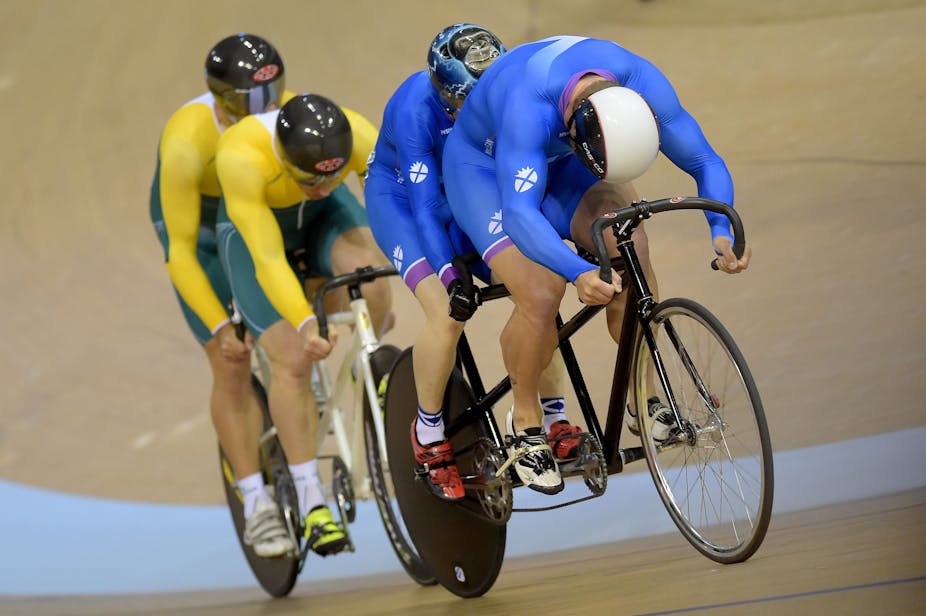Australian athletes at the Commonwealth Games won a stack of medals over the weekend, bringing the nation to the top of the medal tally. Of the Aussie medal winners, para-swimmer Daniel Fox took gold in the 200m freestyle (where he also broke his own world record in the heats) and para-cycling pair Kieran Modra and Jason Niblett were edged out of first place by Scotland in the sprint B tandem.
But para-sports haven’t always been part of the Commonwealth Games schedule. In fact, this is just the fourth Commonwealth Games that para-sport competitors have been included.
The para-sport athletes at these Games are not just athletes with physical disability, but also those with vision impairment, amputees and those with cerebral palsy, head injury or stroke.
And like athletes that compete at the Paralympics, those at the Commonwealth Games are elite performers who have gone through rigorous selection criteria to make the team – they are the best of their classes.
The calibre of para-sport athletes present at the Commonwealth games include the wheelchair racer Kurt Fearnley who is probably the best known Paralympic athlete in Australia.
He will be competing in the Men’s 1,500m T54 wheelchair race tomorrow (with the final held on Thursday), although he’s better known for his efforts racing in wheelchair marathon events at the Paralympics and cities around the world.
But what many people don’t know is that from as early as the 1970s, the Commonwealth Games began to conceptualise the bringing together of para-sports as part of an integrated Commonwealth Games sport program.
Para-sporting Commonwealth history
The first demonstration para-sport events were held at the 1994 Commonwealth Games in Victoria, British Columbia.
Manchester 2002 became the first Commonwealth Games to fully integrate athletes with disabilities in the sport program.
In the Manchester 2002 program there were 10 full medal events across five para-sports including athletics, lawn bowls, swimming, table tennis and weightlifting, and the number of para-sport events integrated within the Commonwealth Games program has only increased since.
Australia played its part in the development of para-sports at the Melbourne 2006 Commonwealth Games with 12 full medal events competed for by 189 athletes from 25 nations in athletics, swimming, table tennis and powerlifting.
By Delhi 2010 there were 15 full medal events in athletics, lawn bowls, powerlifting and swimming.
In Glasgow there are five para-sports on the program involving athletics, swimming, powerlifting, lawn bowls and, for the first time, track cycling. Australian pairing Brandie O'Connor and Breanna Hargrave won bronze in the para-cycling debut last week.

Athletes will be competing for a total of 22 medals across the five sports, which is a modest number of medals compared to the overall program of 261 medal events on offer.
Yet, unlike the demonstration disability sport events held within the Olympic Games program, all para-sports events medals have always counted towards the medal tally for national teams.
To fully understand which events and which disabilities are represented one must navigate the very confusing Paralympic classification system.
The Paralympic classification system is based on disability type:
- amputee
- cerebral palsy
- intellectual disability
- vision impaired
- wheelchair
- les autres (literally “the other”).
Also, depending upon the disability type, there’s an assessment of their physical, vision or intellectual impairment based on ten classifications:
- reduced muscle power
- passive range of movement
- loss of limb or limb-deficiency
- leg-length difference
- short stature
- hypertonia (abnormal increase in muscle tension)
- ataxia (lack of co-ordination of muscle movements)
- athetosis (unbalanced, involuntary movements)
- visual
- intellectual
However, while the classification system is complex, medically-based and (amongst para-sport athletes and officials) contentious, all you have to do as a spectator is focus on the tremendous competition that the “super-crip” athletes provide and enjoy what they do best.

So what’s in store for the rest of these Commonwealth Games?
The para-sport schedule continues to the end of the Games, and if you’re keen on watching the incredible speed, agility and strength of para-sport athletes, here are the remaining event times (in AEST):
Monday, 28 July
Swimming
05:37-05:42 (Tuesday): Men’s SM8 200m IM (S7 eligible)
Athletics
08:00-09:05: Men’s F42/44 discus
06:00-06:05 (Tuesday): Women’s T12 100m
06:40-06:45 (Tuesday): Men’s T37 100m
Tuesday, 29 July
Swimming
06:03-06:10 (Wednesday): Women’s SM10 200m IM (SM9 eligible)
Thursday, 31 July
Athletics
05:20-05:35 (Friday): Women’s T54 1500m
05:35-05:40 (Friday): Men’s T54 1500m
Lawn Bowls
18:45-11:45: Open triples (B6/B7/B8) - physical impairment
Saturday, 2 August
Powerlifting
20:00-22:00: Women’s lightweight (up to 61kg)
20:00-22:00: Women’s heavyweight (from 61.01kg)
00:00-06:00 (Sunday): Men’s lightweight (up to 72kg)
04:00-08:00 (Sunday): Men’s heavyweight (from 71.01kg)

